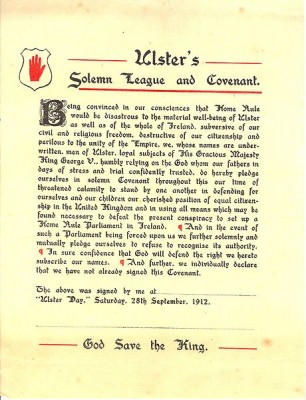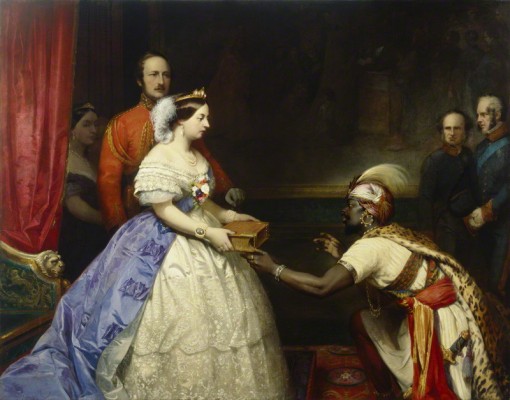What was the Ulster Covenant whose centenary is being commemorated on “Ulster Day” 29 September really about? 400,000 signed the Solemn League and Covenant and the Women’s Declaration in a vast demonstration of public opinion that still impresses today.
The production of the largest Union Jack is history, 48’x25’was an example of PR sureness of touch that Unionism was never to equal although often tried to emulate. Nobody was killed. But how strong was the threat of force implicit in the event?
The topic was reviewed by leading historians at a two day conference in King’s College London last week. Many people believe it was tragic that Home Rule didn’t succeed. It might have kept the south in the Union in some form, or led eventually to an Irish existence separate from Britain acceptable to all. Either would have spared us decades of turmoil. The conference went part of way to showing us why it didn’t happen and why blaming one side or the other is pretty futile. What struck me was is how very different society was a century ago in spite of the loud echoes.
The conference was sponsored by the Irish government and opened by the Tanaiste Eamon Gilmore with a few generous remarks about the Unionism of a century ago and contemporary references centered around Carlisle Circus. The Irish State has of course long followed a more inclusive approach towards Unionism in the interests of improving relations and keeping all political options open in the future, including unity by consent. What follows are some notes and reflections from the conference. Bearing in mind what is often thought of as the immobilisme of our politics, the differences are at least as striking as the similarities present in the legacy.
- The “Irish Question” has all but disappeared from British politics. In 1912, they talked of little else.
- “Playing the Orange card” was not a mere cynical tactic. To Conservatives and many others, surrendering to Home Rule was a betrayal of constitutional principles and a threat to the survival of the Empire (the latter at least, presciently enough).
- Why was such an apocalyptical view taken of the modest powers proposed for Home Rule? One answer is that even the liberal strain in Ulster Unionism held that Catholics because of their religion were insufficiently free in their minds to be able to govern well. This partly explains why Carson and Redmond who know and liked each other as colleagues at the Dublin Bar were unable to bridge the gap.
But the familiar paradoxes – or perhaps contradictions – are salutary. Unionists, both of the British and Ulster variety thought of themselves not as rebels but as defenders of the British constitution embodied in the Crown even if they had to use force against the elected government to prevail.
The appeal of the Covenant was distinctly one sided. Proclamation of the Republic at the GPO in 1916 called out to all Irish people regardless of what they thought, whereas the Ulster Covenant identified only with Protestants.
Did they really mean it?
Paul Bew on Nationalism and Unionism 1912 -1922
The threat of the Covenant shows they really did mean it. But did meaning it entail the use of force? “Every means” at that stage probably meant withholding taxes and not gun running, (similar to the Sinn Fein manifesto of 1918). But the Conservatives probably had at least foreknowledge of the Larne gun running. The later events of the counter revolution of the Right up to August 1914 probably undermined elements of the British constitution.
Charles Townshend on the politics of militarisation.
All that drilling north and south didn’t necessarily add up to the inevitability of armed clashes between the two sides or with the Army. Drilling provided a way of keeping solidarity and discipline and was good PR for the cause. Arms up to the Larne gun running were few and even afterwards the wide variety of weapon types hampered military effectiveness. Someone from the floor added that even up to the 1970s some people were still hiding their grandfathers’ guns imported from the Austro-Hungarian empire. The big question remains: while the threat of some sort of clash increased by 1914, would the UVF commanded by former British officers have really stood up to the British Army – assuming Curragh mutiny sentiment in that body did not prevail? Some in the UVF were keen for a fight with the Irish Volunteers, but overall, we shall never know. However during the Great War, something like the Easter Rising was probably unavoidable.
How important was religion – “Home Rule is Rome Rule”?
Paul Bew confessed to struggling over the significance of religion in politics. “Part of the reason the Troubles ended was that no one takes religion seriously any more unlike 1912.” The fear of a theocratic ultramontane Catholic state was real.
Graham Walker on the pulse of Protestant Ulster
The Covenant was in part a democratic exercise. Protestant Ulster had been sidelined. Home Rule had been promised over their heads. But what sort of democratic elements? They included a repudiation of landlordism, opposition to Catholic church’s control of education, both opinions being true to the liberal tradition. Much attention is given to the rhetoric of Carson and the other leaders. More study is needed of the social strata below.
David Fitzpatrick on why one quarter of Ulster Protestantism dissented
The UVF and Ulster Clubs were minority pursuits compared to the Covenant signing. Many had liberal views. Other thought that intimidating Asquith’s government into abandoning Home Rule was the only way to prevent a bloodbath. Southern unionists were much preoccupied by the threat of civil war. Some argued that Home Rule might not do them much harm, while placating Catholics. The clergy of the Church of Ireland whose members were the top and bottom of society had greater institutional inhibitions than the Presbyterians over opposing Home Rule but nevertheless provided many Orange Order chaplains and opened church doors for Covenant signing. Some clergy was coerced by their flock.
Roy Foster on Protestant nationalists and the revolutionary generation
The commemoration of the 98 rebellion in 1898 helped create the cult of Wolf Tone. The cult of Robert Emmett greatly affected Patrick Pearse. The Quaker Bulmer Hobson “with the support of repentant gentry” helped to revitalise the Irish Republican Brotherhood and founded the Dungannon Clubs ( recalling the United Irishmen) and the Fianna scouting movement with the Catholic Fenian Denis McCullough. ( though both were sidelined in 1916 and afterwards). FJ Biggar expressed his own homoerotic but probably unconsummated impulses in his own camps for his boy bands. The idea of the cleansing power of violence was in vogue. “If only we could be left free to fight the battle among ourselves.” (Roger Casement). “Three cheers for Carson’s volunteers” ( Eoin MacNeill). 1912 challenged nationalist assumptions about the viability of Home Rule and brought about the partition of the mind.
Contemporary relevance.
Paul Bew
The Scottish referendum affects how we view the Ulster Crisis. The idea of partition was grudgingly accepted by the main parties by 1914. 1914 introduced the consent principle into the crisis. But as Carson warned, although they set up devolution in 1920 that didn’t settle the problem. The Westminster parties made the same mistake in the 1980s and 90s over Scotland. Today the impulses for Scottish separation are far weaker but even so, we don’t know what will happen.
Arthur Aughey on what is living and what is dead in the Covenant
“The Secret of England’s greatness”( the Thomas Jones Barker portrait also depicted on an Orange banner) is dead.
So is Belfast as a centre of world shipbuilding.
But the Covenant reminds us of the complex interrelationships in the British Question. We are all Gladstonians ( home rulers/devolutionists) now. The Union may be a constitutional artifice but it is not an artificial entity.
The Public Record Office of Northern Ireland (PRONI,) which has decamped from near the Balmoral site of the great Covenant ceremony to the heritaged Titanic Quarter has a great website where those concerned can find the signatures of their forebears – and much else. A full account of the conference will be published soon.
Former BBC journalist and manager in Belfast, Manchester and London, Editor Spolight; Political Editor BBC NI; Current Affairs Commissioning editor BBC Radio 4; Editor Political and Parliamentary Programmes, BBC Westminster; former London Editor Belfast Telegraph. Hon Senior Research Fellow, The Constitution Unit, Univ Coll. London
Discover more from Slugger O'Toole
Subscribe to get the latest posts to your email.

